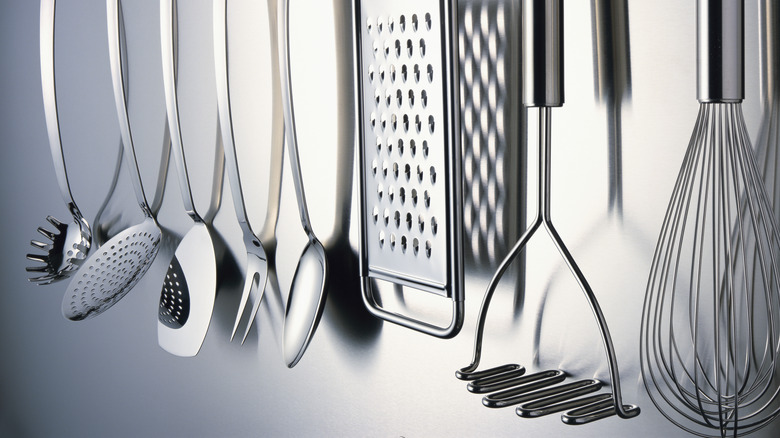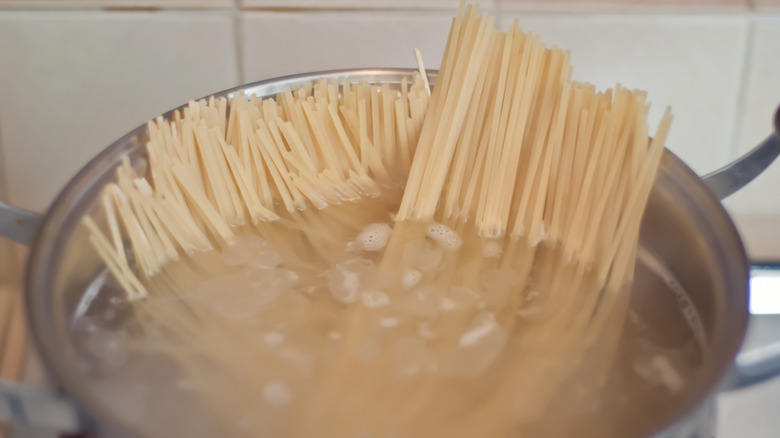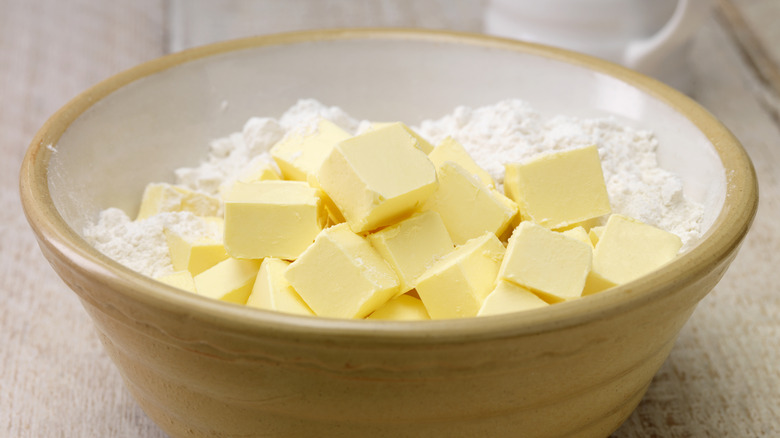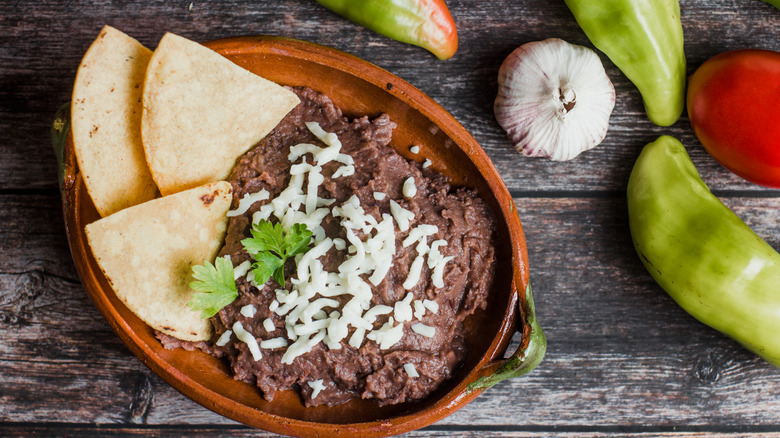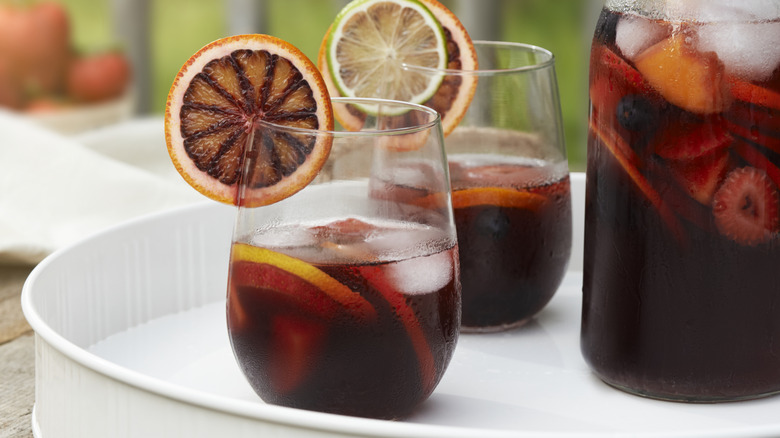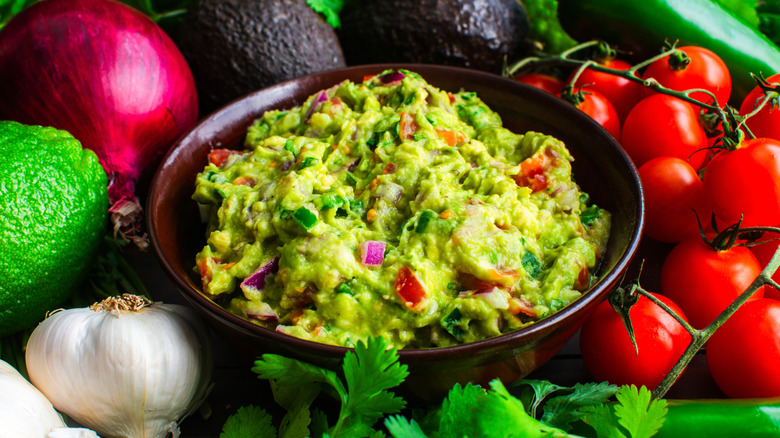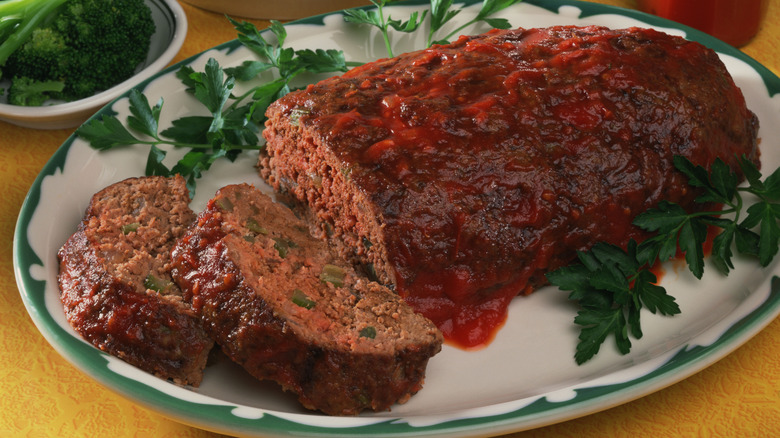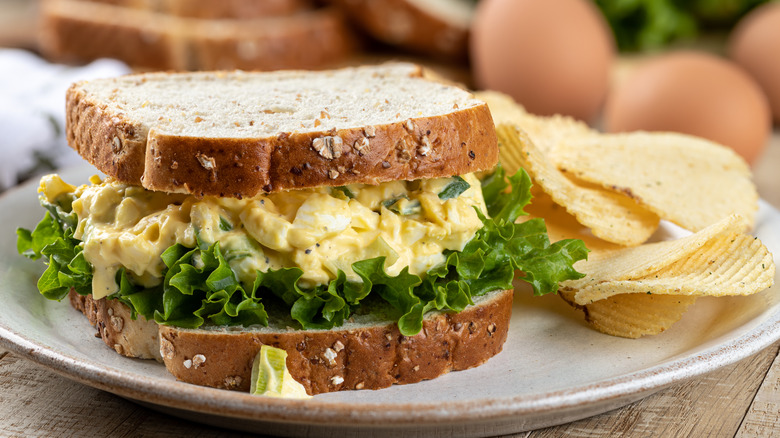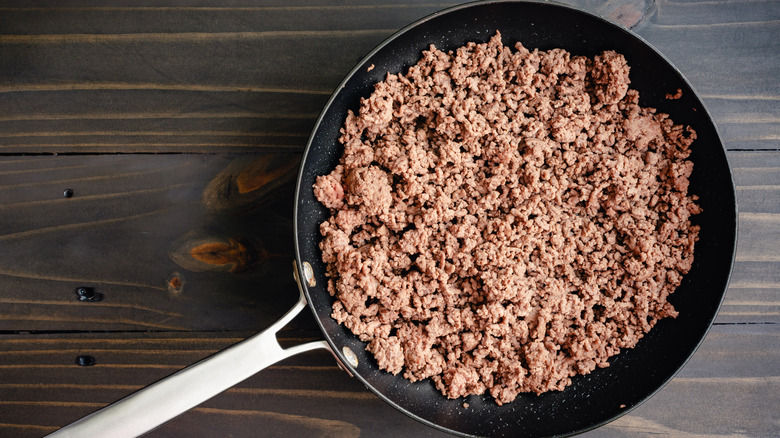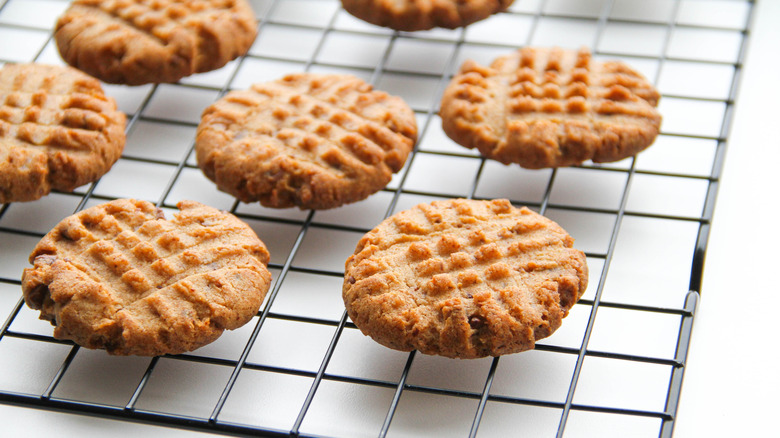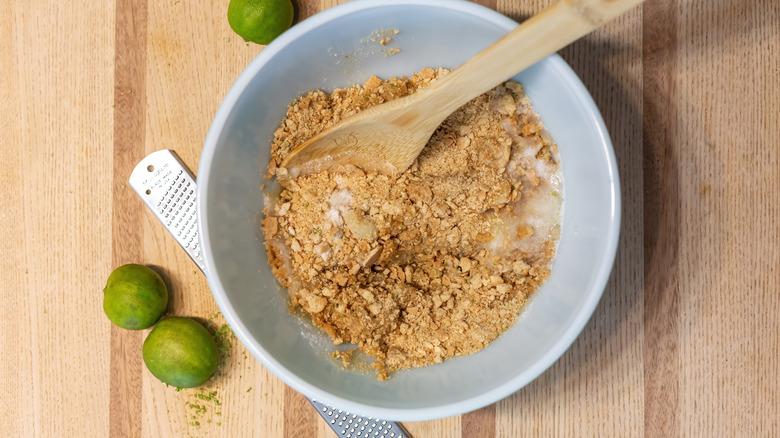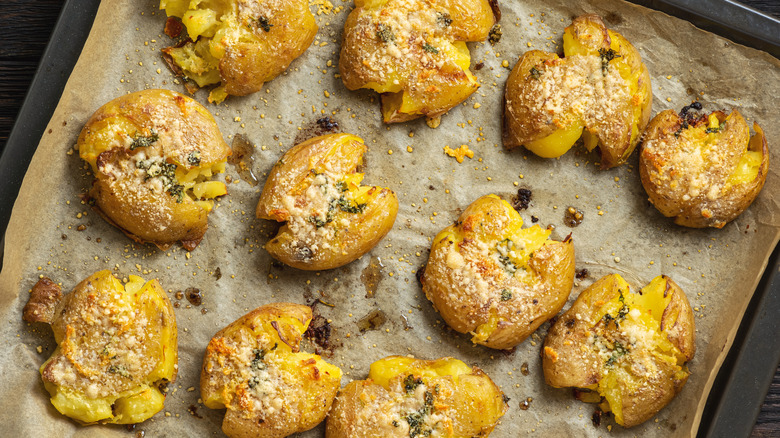11 Ways To Use A Potato Masher Other Than For Spuds
We may receive a commission on purchases made from links.
While we all love the high-tech wizardry of the modern home kitchen, old-school, no-tech gadgets such as a classic potato masher remain standard kitchen gear for a reason: They work. The same basic design your great-grandmother used works just as well today as it did in the horse-and-buggy era — and without all the complicated assembly and cleaning required by a food processor or stand mixer. Even better — especially for home cooks who are short on kitchen space and cash — potato mashers are cheap, easy to store, and last forever.
Some efficiency-minded cooks, however, hate the idea of tools that only do one thing. If you only make mashed potatoes a few times a year, why waste valuable kitchen real estate on a masher when other tools can also do the job? This, however, is the wrong way to look at the problem. Instead, if you like the speed and ease a potato masher offers, think outside the box and consider other ways it can be useful in the kitchen. For instance, a tool that can mash potatoes quickly can also mash sweet potatoes for an updated shepherd's pie. And if it can mash sweet potatoes, why not use it to mash squash for your next wintery butternut squash soup? But an old-fashioned potato masher can do much more than just smoosh soft foods. Here are some surprising new ways you can put your trusty masher to work.
Use your masher to keep pasta from clumping
Long strands of pasta such as spaghetti and fettucine are a slurp-worthy pleasure — unless they get stuck to each other while cooking. If you don't catch the problem and untangle them in time, you'll end up with a knotted, gummy mess. And sorry, adding oil to your cooking water won't help. Since oil floats on water, it can't make its way down into the pot to lubricate your pasta. Instead, it'll coat the cooked pasta once it's drained and prevent your sauce from binding to it.
So what should you do instead? First, make sure to cook your pasta in a generous amount of water so it has room to move around. Second, wait until the water is boiling aggressively before adding your pasta. And finally, break out your potato masher — its large surface area makes it a great tool for pushing dry pasta into the water and for separating any clumps of pasta strands that start to form.
Your masher is a great pastry blender
If you're a baker, you know that preparations such as pie and biscuit dough require you to cut cold shortening into flour to form a crumbly mixture — the little nubs of shortening that remain intact are what give the finished bakes their flakiness and lift. Several methods exist for this step, each with its proponents. Some people recommend using a pair of knives, one in each hand, to literally cut up the shortening and combine it with the flour. Others recommend forks, specialized pastry blenders, or simply your fingers.
But if you want to get the job done quickly and don't want to get your fingers dirty, you have another option: your potato masher. Like the other tools, it effectively breaks up chunks of butter or other solid shortening, and with its wide, flat surface, it can cover more ground more quickly. It also helps distribute the shortening evenly through your dough, ensuring a consistently attractive texture.
It makes refried beans a snap
Serious Mexican food fans know that canned refried beans, convenient as they are, can't begin to match the flavor of homemade. So if you want your next Taco Tuesday to be truly memorable, it might be worth your while to plan ahead and make the beans yourself. Thankfully, the first step to making refried beans (cooking dried beans the old-fashioned way) is mostly hands-off work – you just need to keep an eye on the pot and budget enough time for them to cook to tenderness.
The next step, mashing and frying the beans, requires a bit more elbow grease. Here again the handy potato masher can come to the rescue. It easily reduces fully cooked beans to a rough puree, and is a lot faster to clean than a food processor covered in bean residue. Unless you put in a bit of effort, your hand-mashed beans won't be as silky-smooth as the canned variety — but for many diners, the little bits of cooked beans and aromatics are part of what give made-from-scratch refried beans their character.
A masher is also a great cocktail muddler
Large-batch cocktails are a great option if you're a busy party host. A big pitcher of margaritas or fruity sangria tells guests you're thinking of them and want them to have a good time while sparing you the trouble of mixing individual cocktails for everyone. It also looks neater and more refined than a tableful of booze and mixer bottles for guests to concoct themselves.
Even better, large-batch cocktails are just as easy to make as a single cocktail — you just need to scale everything up. The only difference are the tools you'll need to use: long-handled cooking spoons rather than cocktail stirrers, for instance. And if your cocktail of choice features fresh fruit or herbs — and many cocktails that look great in big pitchers do — be sure to have your potato masher on hand. It's a surprisingly efficient tool for muddling large quantities of fresh fruit in batches of cocktails or punch. Not to mention, it works a lot faster than the big spoons typically used for the task.
It works wonders on guacamole
Guacamole is super simple to make, but success is all about timing. First, your avocados must be at the perfect point of ripeness, soft enough to mash easily but not so ripe they're starting to blacken on the inside. Second, you need to get it to your guests quickly — as everyone knows, guacamole can turn unappetizingly brown if kept exposed to open air for more than a few hours, so you need to make it right before serving. On top of that, you need to work quickly when making guacamole so it doesn't darken before you bring it to the table.
Thus, the moment you cut open your avocados and place them in a bowl to mash, the clock is ticking. If you're making guacamole by hand (which is recommended if you want an appealing, slightly chunky texture) your potato masher can get the job done faster and more easily than a fork. You might not notice the difference if you're mashing up only one or two avocados, but if you're making a large batch, your arm muscles will thank you.
A masher lets you keep your hands clean when mixing meatloaf
For many American diners, meatloaf is the among the most welcoming and comforting of meals. It's also easy to make, which is another reason it's a staple among home cooks. Even better, it can take on any flavor profile you want — from sweet to spicy to rich, with special ingredients such as bacon and cheese. And many cooks love the hands-on process of making a homemade meatloaf — the opportunity to plunge their hands into a big bowl of meatloaf mix to blend everything together just feels satisfying and fun.
Others, however, dread the very thought of touching a mass of cold, slimy raw meat and eggs. They might grit their teeth and put up with it, but they'll hate every moment. Or they'll struggle to mix everything with a spoon or fork — a much longer and less efficient process. If this sounds familiar, we see you — and we recommend switching from a spoon to a potato masher. It combines meatloaf ingredients much more quickly while letting you keep your hands clean. And since you'll likely be making mashed potatoes to go with your meatloaf, you might as well keep your masher at the ready.
It can speed up your egg salad production
Egg salad is a favorite for both casual picnics and fancy tea sandwiches. But while it's fundamentally simple — just hard-boiled eggs, a bit of mayo, and as many or few flavorings as you like — making it can be fraught with issues. First, there's a whole lot of controversy about the proper technique for boiling eggs, and a separate set of arguments about the right way to peel them. And once you've managed to peel your eggs, you have to chop them up to make a filling with a spreadable consistency. Dicing them neatly with a knife may be fine for small batches, but can get seriously tedious if you're making egg salad for a crowd.
Your potato masher can help you speed up this process — just dump your peeled eggs in a mixing bowl and mash away. The masher's surface is big enough to smash an egg or two with a single well-aimed blow, and if you prefer a smoother consistency to your egg salad, just keep mashing until you get it — it won't take long.
Use the tool to crumble ground meat quickly
Ground meat has long been the savvy cook's secret weapon for feeding a crowd affordably and well. Stretched out as a star ingredient in a pasta sauce or filling for stuffed vegetables, tacos, or a range of savory pastries, a modest quantity of ground meat can make a satisfying meal for a big group.
To ensure eaters get a bit of meaty goodness in every bite, many recipes call for cooks to break up the ground meat mass into tiny crumbles as it cooks. This needs to happen fairly quickly, or the meat will cook into a bunch of irregular lumps, or worse, a single solid lump. While most of us use spatulas or cooking spoons for this task, a potato masher is an even better option. Mashing the meat and stirring as it cooks ensures it breaks up quickly and reaches its desired crumbly consistency faster.
It's an easy way to emboss your cookies
Many of us have fond childhood memories of making cookies with loved ones. Chances are, our patient elders did all the measuring and prep, and we "helped" by rolling the dough into balls or operating the cookie cutter. And if you were lucky enough to make traditional peanut butter cookies, you had an especially fun task: making that signature grid pattern on the surface by pressing down on it twice with a fork.
We love peanut butter cookies just as much now as when we were kids, but baking them for a crowd, satisfying as it still is, doesn't feel the same for a time-pressed adult as for an excited 5-year-old with no deadlines or cares in the world. So when we discover a way to speed up the process without sacrificing quality, we take it. For instance, if you want that cute pattern but don't have a lot of time (or an eager child around), just press down on your cookies with your potato masher — the grid pattern on traditional mashers gives you that classic look in seconds.
It makes cracker crumbs without making a mess
Cracker and cookie crumbs may be humble ingredients, but they're essential for many dishes — cheesecakes and other desserts are built on a crust of graham cracker crumbs, and savory cracker crumbs add flavor and crunch to casseroles and breading. Graham cracker crumbs are such a culinary staple that you can buy ready-made crumbs by the box. But if you want to save a dollar or two or need crumbs from other types of cookies or cracker, you'll have to make them yourself.
And this can be a messy process. A food processor is the fastest method, provided you have one. If not, a traditional method is to use a rolling pin. It does the job, but even if you put your crackers in a plastic bag or between sheets of plastic wrap first, there's a good chance you'll have to deal with flying cracker crumbs falling onto your counter and floor. Your potato masher offers a neater way to hand-grind crackers or cookies. Place them in a large bowl, then go to town with the masher. The crumbs will stay in the bowl where they belong — less waste and less stress.
It can smash, as well as mash, potatoes
Smashed potatoes are such a simple idea and so easy to make it's surprising they've only jumped onto our radar in the last few years. These cute little bites, crispy on the outside and tender within, are great eaten out of hand with dip on the side, like hot, fat potato chips, or as a knife-and-fork side dish with a plated meal. They're nothing more than tiny whole potatoes that are boiled in their skins, pressed until slightly flattened, then quickly pan-fried or baked at high heat until crunchy. They offer all the textural appeal of french fries with a fraction of the oil or work.
To speed up the already fast prep work, bring out your potato masher – it makes the slightly fiddly task of flattening the potatoes a snap. Just give each cooked potato a firm press with the masher, taking care not to smash it so hard it breaks (a few cracks along the edges are expected and turn nice and crunchy when the potatoes are fried or baked). As a bonus, the masher may leave imprints from its surface on your potatoes, adding even more texture and crunch.
